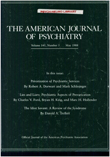Family characteristics of 105 patients with bulimia
Abstract
The authors compared 105 patients who met DSM-III criteria for bulimia with 86 control subjects on measures of family environment and presence of eating disorders. Bulimic patients' perceptions of their families included low cohesiveness, a lack of emphasis on independent and assertive behavior, and a high level of conflict coupled with a low emphasis on open expression of feelings. Families of bulimic subjects had achievement expectations comparable to those of control families, but the former placed less emphasis on intellectual and recreational activities. The high disorganization of the families of bulimic subjects was associated with severity of symptoms.
Access content
To read the fulltext, please use one of the options below to sign in or purchase access.- Personal login
- Institutional Login
- Sign in via OpenAthens
- Register for access
-
Please login/register if you wish to pair your device and check access availability.
Not a subscriber?
PsychiatryOnline subscription options offer access to the DSM-5 library, books, journals, CME, and patient resources. This all-in-one virtual library provides psychiatrists and mental health professionals with key resources for diagnosis, treatment, research, and professional development.
Need more help? PsychiatryOnline Customer Service may be reached by emailing [email protected] or by calling 800-368-5777 (in the U.S.) or 703-907-7322 (outside the U.S.).



